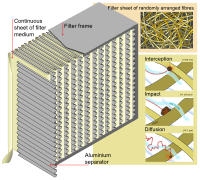
Photo from wikipedia
Abstract The use of filtering facepiece respirators (FFRs) of various types increased dramatically by both workers and the public during the ongoing COVID-19 pandemic. This increased use has, likewise, instigated… Click to show full abstract
Abstract The use of filtering facepiece respirators (FFRs) of various types increased dramatically by both workers and the public during the ongoing COVID-19 pandemic. This increased use has, likewise, instigated a proliferation of research on the qualities of FFRs. An aspect of FFR development and optimization involves the use of mathematical models that predict filter efficiency based on various filter characteristics while also considering a number of particle capture forces. An evaluation of current literature failed to identify a publication that provides a comprehensive assessment of the models developed to predict filter efficiency. The purpose of this review was, therefore, to describe models developed to include the forces associated with diffusion, interception, impaction, and electrostatic attraction as they contribute to the efficiency of an entire filter. The literature review was augmented with figures created with the use of many of the models discussed to compare different models of the same force as well as to illustrate the influence of electrostatic forces on overall filter efficiency.
Journal Title: Journal of Occupational and Environmental Hygiene
Year Published: 2022
Link to full text (if available)
Share on Social Media: Sign Up to like & get
recommendations!